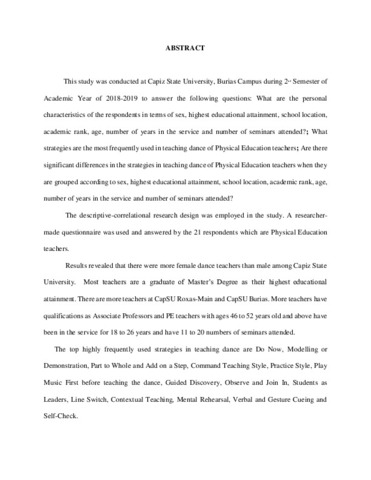Strategies in teaching dance of physical education teachers of Capiz State University
| dc.contributor.advisor | Madiclum, Rodyard B. | |
| dc.contributor.author | Emilia, Samantha J-Loe L. | |
| dc.contributor.author | Layes, Jennifer L. | |
| dc.contributor.author | Villasis, Renejoy P. | |
| dc.date.accessioned | 2024-03-20T03:21:47Z | |
| dc.date.available | 2024-03-20T03:21:47Z | |
| dc.date.issued | 2019-02 | |
| dc.identifier.citation | Emilia, S.J.L., Layes, J.L., & Villasis, R.P. (2019). Strategies in teaching dance of physical education teachers of Capiz State University [Undergraduate thesis, Capiz State University Burias Campus]. CAPSU Institutional Repository. | en |
| dc.identifier.uri | https://repository.capsu.edu.ph/handle/123456789/210 | |
| dc.description.abstract | This study was conducted at Capiz State University, Burias Campus during 2nd semester of the academic year of 2018-2019 to answer the following questions: what are the personal characteristics of the respondents in terms of sex, highest educational attainment, school location, academic rank, age, number of years in the service and number of seminars attended?; what strategies are the most frequently used in teaching dance of physical education teachers; are there significant differences in the strategies in teaching dance of physical education teachers when they are grouped according to sex, highest educational attainment, school location, academic rank, age, number of years in the service and number of seminars attended? The descriptive-correlational research design was employed in the study. A researcher-made questionnaire was used and answered by the 21 respondents which are physical education teachers. Results revealed that there were more female dance teachers than male at Capiz State University. Most teachers are graduates of master’s degree as their highest educational attainment. There are more teachers at CapSU Roxas-Main and CapSU Burias. More teachers have qualifications as associate professors and PE teachers ages 46 to 52 years old and above have been in the service for 18 to 26 years and have 11 to 20 numbers of seminars attended. The top highly frequently used strategies in teaching dance are do now, modeling or demonstration, part to whole and add on a step, command teaching style, practice style, play music first before teaching the dance, guided discovery, observe and join in, students as leaders, line switch, contextual teaching, mental rehearsal, verbal and gesture cueing, and self-check. The profiles of the respondents were significantly affected by the strategies in teaching dance according to sex but there were no diminutive differences in terms of highest educational attainment, school location, academic rank, age, years in service, and number of seminars attended. | en |
| dc.language.iso | en | en |
| dc.publisher | Burias Campus, Capiz State University | en |
| dc.subject | strategies | en |
| dc.subject | dance | en |
| dc.subject | teaching | en |
| dc.subject | physical education | en |
| dc.subject | teaching strategies | en |
| dc.subject.lcsh | Dance--Study and teaching | en |
| dc.subject.lcsh | Strategy--Study and teaching (Secondary) | en |
| dc.subject.lcsh | Teaching strategies | en |
| dc.title | Strategies in teaching dance of physical education teachers of Capiz State University | en |
| dc.type | Thesis | en |
| dc.contributor.chair | Madiclum, Rodyard B. | |
| dc.contributor.committeemember | Vestidas, Angeline L. | |
| dc.contributor.committeemember | Mejia, Glen Rose L. | |
| thesis.degree.discipline | Music, Art, Physical Education and Health (MAPEH) | en |
| thesis.degree.grantor | Capiz State University Burias Campus | en |
| thesis.degree.level | Undergraduate | en |
| thesis.degree.name | Bachelor of Secondary Education | en |
| thesis.degree.department | College of Education | en |

